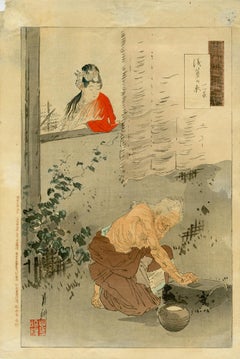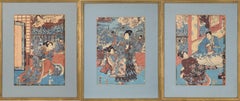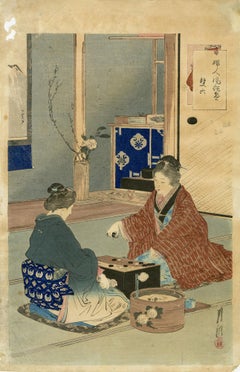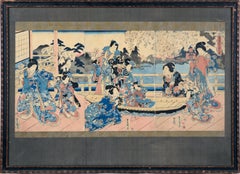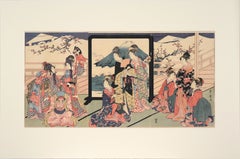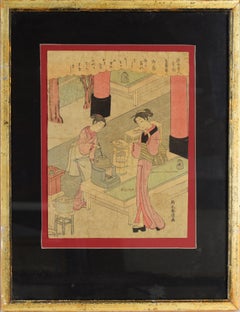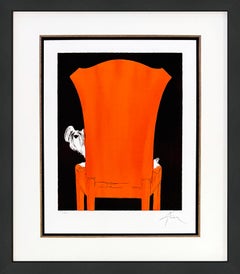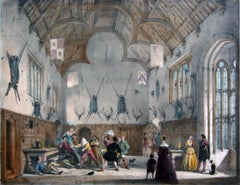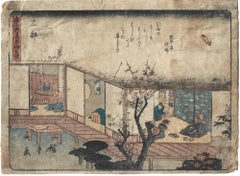Edo Interior Prints
to
1
4
2
3
1
Overall Width
to
Overall Height
to
561
438
117
106
43
36
35
29
19
15
12
10
9
2
1
1
3
6
1
3
5
5
10
6
5
3
3
2
1
1
1
1
10
10
7
5
4
5
10
Style: Edo
The Lonely House at Asajigahara.
Located in Middletown, NY
A scene from a series of ghost stories and spooky rural legends.
Tokyo: Matsuki Heikichi, 1896.
Woodcut in ink with embossing and hand-coloring in watercolor on handmade mulberry pa...
Category
Late 19th Century Edo Interior Prints
Materials
Watercolor, Handmade Paper, Woodcut
The Four Seasons: Spring Japanese Woodblock Triptych ink on Paper Tales of Genji
Located in Soquel, CA
The Four Seasons: Spring - Japanese Woodblock Triptych in Ink on Paper
Colorful kabuki scene by Utagawa Kuniteru (Japanese, active 1818-18...
Category
Early 19th Century Edo Interior Prints
Materials
Paper, Ink, Woodcut
Two Women Playing Sugoroku from "Comparison of the Customs of Beauties."
Located in Middletown, NY
A scene from a vanishing Japan.
Two Women Playing Sugoroku from "Comparison of the Customs of Beauties."; The Customs and Manners of Women
Japan: Matsuki Heikichi, 1891.
Woodblock ...
Category
Late 19th Century Edo Interior Prints
Materials
Watercolor, Handmade Paper, Woodcut
Elegant Amusements of Eastern Genji - Japanese Triptych Woodblock Print on Paper
Located in Soquel, CA
Elegant Amusements of Eastern Genji - Japanese Triptych Woodblock Print on Paper
Dynamic woodblock print with several elegantly dressed figures by Utag...
Category
1850s Edo Interior Prints
Materials
Paper, Ink, Woodcut
"Toy Horse Dance" Japanese Woodblock Triptych with Beauties and Mt Fuji
Located in Soquel, CA
"Toy Horse Dance" Japanese Woodblock Triptych with Beauties and Mt Fuji
Vibrant three-panel woodblock print by Utagawa Toyohiro (Japanese,...
Category
Early 20th Century Edo Interior Prints
Materials
Ink, Rice Paper, Woodcut
Deutzia Flowers: The Wife of Kasamori - Original Woodblock Print
Located in Soquel, CA
Deutzia Flowers: The Wife of Kasamori - Original Woodblock Print
Deutzia Flowers: The Wife of Kasamori, from the Series "Beauties of the Floating World Associated with Flowers" by S...
Category
1760s Edo Interior Prints
Materials
Woodcut, Ink, Rice Paper
"House Cleaning in Preparation for the New Year" - Japanese Woodblock on Paper
Located in Soquel, CA
"House Cleaning in Preparation for the New Year" - Japanese Woodblock on Paper
House cleaning scene by Kitagawa Utamaro (Japanese, 1753-1806). This print was originally published around 1796-1799, with this example being a later reprint. The full scene is five sheets - there are two more sheets to the right that show more members of the house. However, it is these three sheets that contain the majority of the action - a maid sweeping at a mouse, a lady fainting, and a painting moved aside to allow for cleaning.
Presented in a new black mat.
Mat size: 24"H x 38"W
Paper size: 17.75"H x 33"W
Print Impression: 14.63"H x 29.5"W
Utamaro Kitagawa...
Category
18th Century Edo Interior Prints
Materials
Rice Paper, Woodcut
No. 45, View of Akasaka from "Comical Views of Famous Places in Edo" Woodblock
Located in Soquel, CA
No. 45, View of Akasaka from "Comical Views of Famous Places in Edo" Woodblock
Whimsical woodblock print by Utagawa Hirokage (Japanese, active 1855–1865). Four people are sitting on...
Category
1860s Edo Interior Prints
Materials
Rice Paper, Woodcut
Dyeing Paper
Located in Middletown, NY
Japan: circa 1770.
Woodcut on cream laid paper, 7 1/4 x 2 1/2 inches (182 x 63 mm), narrow margins. Laid down to non-archival board with scattered soiling and some adhesive staining...
Category
Late 18th Century Edo Interior Prints
Materials
Handmade Paper, Laid Paper, Woodcut
Scribe and Personal Assistant to the Shogun - Japanese Woodblock Print on Paper
Located in Soquel, CA
Scribe and Personal Assistant to the Shogun - Japanese Woodblock Print on Paper
Detailed woodblock print by an unknown artist, In the style of Suzuki Harunobu. There are two women i...
Category
19th Century Edo Interior Prints
Materials
Paper, Ink, Woodcut
$920 Sale Price
20% Off
Related Items
Le Petit Chien Sur Le Fauteuil (framed hand signed lithograph)
By René Gruau
Located in Aventura, FL
Le Petit Chien Sur Le Fauteuil (The Little Dog on the Armchair). Lithograph in colors on paper. Hand signed lower right by Rene Gruau. Hand numbered 139/300 lower left. Sheet siz...
Category
1990s Edo Interior Prints
Materials
Paper, Lithograph
$750 Sale Price
25% Off
H 35.5 in W 31 in D 1 in
Mid 19thCent. Kings Hall Party Session, Athelhampton, Dorsetshire by Joseph Nash
By Joseph Nash
Located in Soquel, CA
Historical mid-19th century hand tinted lithograph and a lively scene of men and women engaging in a light hearted game of the era by artist Joseph Nash (British, 1808-1878). Signed ...
Category
Mid-19th Century Edo Interior Prints
Materials
Watercolor, Lithograph
$850
H 27 in W 22 in D 2 in
Kabuki actor Nakamura Shikan II by Utagawa Kunisada Edo Japanese Woodblock Print
Located in Soquel, CA
Kabuki actor Nakamura Shikan II by Utagawa Kunisada Japanese Woodblock Print
Wonderful portrait of Nakamura Shikan II, a prominent kabuki actor, in the role of Kisen Hoshi Toyokuni ...
Category
1820s Edo Interior Prints
Materials
Printer's Ink, Rice Paper, Woodcut
$550
H 21.75 in W 16.75 in D 1.25 in
THE WAGON SHOP
Located in Santa Monica, CA
GUSTAVE BAUMANN (1881 – 1971)
THE WAGON SHOP, 1910 (Chamberlain 24)
Color woodcut signed in pencil. Unnumbed from an edition 100 as published in the Hills o’ Brown...
Category
1910s Edo Interior Prints
Materials
Woodcut
THE RUG WEAVER
Located in Santa Monica, CA
GUSTAVE BAUMANN (1881 – 1971)
THE RUG WEAVER, 1910 (Chamberlain 26)
Color woodcut signed in pencil. Unnumbed from an edition 100 as published in the Hills o’ Brown...
Category
1910s Edo Interior Prints
Materials
Woodcut
'The Bath' — Meji Era Cross-Cultural Woman Artist
By Helen Hyde
Located in Myrtle Beach, SC
Helen Hyde, 'The Bath', color woodblock print, edition not stated, 1905, Mason & Mason 59. Signed in pencil in the image, lower right. Numbered '96' in pencil in the image, lower left. The artist's monogram in the block, lower left, and 'Copyright, 1905, by Helen Hyde.' upper right. A superb impression with fresh colors on tissue-thin cream Japanese paper; the full sheet with margins (7/16 to 1 5/8 inches), in excellent condition. Matted to museum standards, unframed.
Image size 16 1⁄4 x 10 1⁄8 in. (413 x 260 mm); sheet size: 19 1⁄4 x 11 1⁄8 in. (489 x 283 mm).
Literature and Exhibition: Back cover illustration of the catalog of the artist’s prints, 'Helen Hyde', Smithsonian Institution Press, 1990; 'The International Block Print Renaissance, Then And Now, Block Prints In Wichita, Kansas, A Centennial Celebration — 1922-2022', Barbara J. Thompson, Wichita Art Museum, 2022 (back cover).
Impressions of this work are held in the following collections: Achenbach Foundation for Graphic Arts, Art Institute of Chicago, Fine Arts Museums of San Francisco (De Young), Harvard Art Museums, Library of Congress, Metropolitan Museum of Art, New York Public Library, Smithsonian American Art Museum, Terra Foundation for American Art, University of Oregon Museum of Art.
ABOUT THE ARTIST
Helen Hyde (1868-1919) was a pioneer American artist best known for advancing Japanese woodblock printmaking in the United States and for bridging Western and Japanese artistic traditions. Hyde was born in Lima, New York, but after her father died in 1872, her family relocated to Oakland, California, where she spent much of her youth.
Hyde pursued formal art education in the United States and Europe. She enrolled in the San Francisco School of Design, where she took classes from the Impressionist painter Emil Carlsen; two years later, she transferred to the Art Students League in New York, studying there with Kenyon Cox. Eager to expand her artistic repertoire, Hyde traveled to Europe, studying under Franz Skarbina in Berlin and Raphael Collin in Paris. While in Paris, she first encountered Japanese ukiyo-e prints, sparking a lifelong fascination with Japanese aesthetics. After ten years of study, Hyde returned to San Francisco, where she continued to paint and began to exhibit her work.
Hyde learned to etch from her friend Josephine Hyde in about 1885. Her first plates, which she etched herself but had professionally printed, represented children. On sketching expeditions, she sought out quaint subjects for her etchings and watercolors. In 1897, Hyde made her first color etchings—inked á la poupée (applying different ink colors to a single printing plate)—which became the basis for her early reputation. She also enjoyed success as a book illustrator, and her images sometimes depicted the children of Chinatown.
After her mother died in 1899, Hyde sailed to Japan, accompanied by her friend Josephine, where she would reside, with only brief interruptions, until 1914. For over three years, she studied classical Japanese ink painting with the ninth and last master of the great Kano school of painters, Kano Tomonobu. She also studied with Emil Orlik, an Austrian artist working in Tokyo. Orlik sought to renew the old ukiyo-e tradition in what became the shin hanga “new woodcut prints” art movement. She immersed herself in the study of traditional Japanese printmaking techniques, apprenticing with master printer Kanō Tomonobu. Hyde adopted Japanese tools, materials, and techniques, choosing to employ the traditional Japanese system of using craftsmen to cut the multiple blocks and execute the exacting color printing of the images she created. Her lyrical works often depicted scenes of family domesticity, particularly focusing on women and children, rendered in delicate lines and muted colors.
Through her distinctive fusion of East and West, Hyde’s contributions to Western printmaking were groundbreaking. At a time when few Western women ventured to Japan, she mastered its artistic traditions and emerged as a significant figure in the international art scene.
Suffering from poor health, she returned to the United States in 1914, moving to Chicago. Having found restored health and new inspiration during an extended trip to Mexico in 1911, Hyde continued to seek out warmer climates and new subject matter. During the winter of 1916, Hyde was a houseguest at Chicora Wood, the Georgetown, South Carolina, plantation illustrated by Alice Ravenel Huger Smith in Elizabeth Allston Pringle’s 1914 book A Woman Rice Planter. The Lowcountry was a revelation for Hyde. She temporarily put aside her woodcuts and began creating sketches and intaglio etchings of Southern genre scenes and African Americans at work. During her stay, Hyde encouraged Smith’s burgeoning interest in Japanese printmaking and later helped facilitate an exhibition of Smith’s prints at the Art Institute of Chicago.
During World War I, Hyde designed posters for the Red Cross and produced color prints extolling the virtues of home-front diligence.
In ill health, Hyde traveled to be near her sister in Pasadena a few weeks before her death on May 13, 1919. She was buried in the family plot near Oakland, California.
Throughout her career, Hyde enjoyed substantial support from galleries and collectors in the States and in London. She exhibited works at the St. Louis Exposition in 1897, the Pan-American Exhibition in Buffalo in 1901, the Tokyo Exhibition for Native Art (where she won first prize for an ink drawing) in 1901, the Alaska-Yukon-Pacific Exhibition in Seattle in 1909 (received a gold medal for a print), the Newark Museum in 1913, a solo show at the Chicago Art Institute in 1916, and a memorial exhibition in 1920, Detroit Institute of Arts, Color Woodcut Exhibition in 1919, New York Public Library, American Woodblock Prints...
Category
Early 1900s Edo Interior Prints
Materials
Woodcut
College of Physicians, from Ackermann's "Microcosm of London."
Located in Middletown, NY
Pugin, Augustus Charles & Rowlandson, Thomas (after).
College of Physicians, from Ackermann's "Microcosm of London."
London: Rudolph Ackermann, 1808. Hand-colored lithograph, 9 1/4 ...
Category
Early 19th Century Edo Interior Prints
Materials
Watercolor, Handmade Paper, Lithograph
Once upon a time in London, Morning, Woodcut print, Vincent Van Gogh, Sunflowers
Located in Deddington, GB
A limited edition woodcut on paper print by Mychael Barratt of Vincent Van Gogh in his bedroom with his dog. Sunflowers appear in the background, brightening up a blue and purple room.
Additional information:
Mychael Barratt
Once upon a time in London, Morning
Woodcut on paper
Signed and titled in pencil
Numbered from the edition of 100
Image size
Height: 27.5 cm
Width: 27 cm
Complete size of sheet
Height: 39.6 cm
Width: 37.5 cm
Depth: 0.2 cm
ARTIST PROFILE: Mychael Barratt was born in Toronto, Canada, however, considers himself to be a Londoner since arriving for what was supposed to be a two-week stay thirty years ago. He is a narrative artist whose work is steeped in imagery relating to art history, literature, theatre and everything else that overfills his bookshelves. He was an artist in residence for Shakespeare’s Globe Theatre...
Category
2010s Edo Interior Prints
Materials
Paper, Woodcut
$440
H 39.6 in W 37.5 in D 0.2 in
Annual Events for Young Murasaki (July) - Tales of Genji - Japanese Woodblock
Located in Soquel, CA
Annual Events for Young Murasaki (July) - Tales of Genji - Japanese Woodblock
Rightmost panel a triptych, depicting monthly events for Wakamurasaki (Young Murasaki). This is the month of July. There appears to be a lesson taking place, possibly for writing or poetry.
Artist: Toyokuni III/Kunisada (1786 - 1864)
Publisher: Ebisu-ya Shoshichist
Presented in a new blue mat.
Mat size: 19"H x 13"W
Paper size: 14.5"H x 10"W
Commentary on the triptych:
In the Edo period, Tanabata was designated as one of the five seasonal festivals, and became an annual event for the imperial court, aristocrats, and samurai families, and gradually came to be celebrated by the general public. Its origins are said to be a combination of the Kikoden festival, which originated from the Chinese legend of Altair and the Weaver Girl, and Japan's ancient Tanabata women's faith. Ink is ground with dew that has accumulated on potato leaves, poems and wishes are written on five colored strips of paper, which are then hung on bamboo branches to celebrate the two stars that meet once a year. Although the illustration is a Genji painting...
Category
1850s Edo Interior Prints
Materials
Printer's Ink, Rice Paper, Woodcut
$975
H 19 in W 13 in D 0.25 in
TOOL BOX 2
By Jim Dine
Located in Aventura, FL
Hand signed on front; numbered on verso by the artist. From the 'A Tool Box' Portfolio. Printed by Christopher Prater; published by Editions Alecto. Artwork is in excellent condition...
Category
1960s Edo Interior Prints
Materials
Screen, Paper
The Great Fire of London, 1666
By James Stow
Located in Middletown, NY
A rare early 19th century view of the Great Fire of London over Ludgate, enhanced with hand coloring.
London: Robert Wilkinson, 1811.
Copperplat...
Category
Early 19th Century Edo Interior Prints
Materials
Handmade Paper, Engraving, Watercolor
"House Cleaning in Preparation for the New Year" - Japanese Woodblock on Paper
Located in Soquel, CA
"House Cleaning in Preparation for the New Year" - Japanese Woodblock on Paper
House cleaning scene by Kitagawa Utamaro (Japanese, 1753-1806). This print was originally published around 1796-1799, with this example being a later reprint. The full scene is five sheets - there are two more sheets to the right that show more members of the house. However, it is these three sheets that contain the majority of the action - a maid sweeping at a mouse, a lady fainting, and a painting moved aside to allow for cleaning.
Presented in a new black mat.
Mat size: 24"H x 38"W
Paper size: 17.75"H x 33"W
Print Impression: 14.63"H x 29.5"W
Utamaro Kitagawa...
Category
18th Century Edo Interior Prints
Materials
Rice Paper, Woodcut
$1,150
H 24 in W 38 in D 0.25 in
Previously Available Items
Beauties Mirrored in the Forms of Flowers - Utagawa Kuniyoshi Japanese Woodblock
Located in Soquel, CA
Beauties Mirrored in the Forms of Flowers - Utagawa Kuniyoshi Japanese Woodblock
A Japanese beauty dressed and posed resembling flowers by Utagawa Kumiyoshi (Japan, 1797 - 1861 ).
A...
Category
Mid-19th Century Edo Interior Prints
Materials
Paper, Ink, Woodcut
H 17.75 in W 14.75 in D 0.5 in
Ishibe, from the series Fifty-three Stations of the Tôkaidô Road
Located in Middletown, NY
Ishibe, from the series Fifty-three Stations of the Tôkaidô Road (Tôkaidô gojûsan tsugi), also known as the Kyôka Tôkaidô
Sanoya Kihei (Kikakudō), c1840.
Woodblock print (nishiki-e)...
Category
Mid-19th Century Edo Interior Prints
Materials
Brass
Dressing Room 53 Stations of Tokaido - Woodblock Utagawa Hiroshige and Kunisada
Located in Soquel, CA
Dressing Room 53 Stations of Tokaido - Woodblock Utagawa Hiroshige and Kunisada
Elegant woodblock print by Utagawa Hiroshige I (Japanese, 1797–1858) and Utagawa Kunisada I...
Category
1850s Edo Interior Prints
Materials
Paper, Ink, Woodcut
Early 20th Century Japanese Woodblock -- Woman Looking At Her Sleeping Kamuro
Located in Soquel, CA
Charming early 20th Century Japanese woodblock of woman looking at her sleeping Kamuro (little servant) or "Mother and Daughter" by Edo period artist Harunobu Suzuki...
Category
Early 20th Century Edo Interior Prints
Materials
Ink, Rice Paper
H 20.75 in W 16.85 in D 0.63 in
"Yonde mitaso" - Geisha with Origami - Japanese Woodblock
Located in Soquel, CA
Depiction of a geisha holding origami by Toyohara Kunichika (Japanese, 1835-1900). Presented in a new cream mat with foamcore backing. No frame. Image size: 14"H x 19.5"W
Toyohara Kunichika (Japanese 1835-1900) grew up in the Kyobashi district of Edo in the midst of merchants and artisans. Kunichika's work stands in contrast to that of many of his contemporaries as he persistently held onto the traditional style and subject matter of the classic Japanese woodcut, unaffected by new Western forms of art. His love of Kabuki inspired him to depict actors in their various roles and varying facial expressions. His skillful use of color and ability to translate the actor's depth of emotion onto the page makes his work some of the most dramatic ever produced. Later on in his career, Kunichika turned primarily to the triptych format as the increased size gave him the space to fully portray the drama and action of the characters represented.
At around the age of eleven Kunichika first studied under the artist (Ichiosai) Toyohara Chikanobu. In 1848, he became an apprentice to the artist Utagawa Kunisada (Toyokuni III, 1786-1865). His first prints as an apprentice were published in the early 1850s. His apprenticeship was formative, as he remained grounded in the Utagawa style he was taught in Kunisada's studio, even after he achieved artistic independence during the mid 1860s-70s.
The name Kunichika is a combination of the artist names of his two teachers, Toyohara Chikanobu and Utagawa Kunisada. Following tradition, he assumed the last character, kuni, from Kunisada's artist's name Toyokuni to which he added the character chika from Chikanobu.
Kunichika's rise to prominence can be seen in his high ratings from the saikenki (a popular guide that rated ukiyo-e artists), in which he was rated #8 in 1865, #5 in 1867 and #4 in 1885. No other Meiji woodblock...
Category
Mid-19th Century Edo Interior Prints
Materials
Ink, Handmade Paper
H 19 in W 13 in D 0.25 in
"Inazuma vs Abumatsu on the Dohyo" Sumo Wrestle Triptych
Located in Houston, TX
Intricate Japanese woodblock print triptych of a sumo match between the wrestlers Inazuma and Abumatsu in the the dohyo, or sumo ring, by the popular artist Utagawa Kunisada in the 1840's.
Artist Biography:
Kunisada was born in 1786 in Honjo, an eastern district of Edo. His given name was Sumida Shōgorō, and he was also called Sumida Shōzō. While growing up, he developed an early talent for painting and drawing. His early sketches at that time impressed Toyokuni, the great master of the Utagawa school and prominent designer of kabuki and actor-portrait prints. In the year 1800 or shortly thereafter Kunisada was accepted by Toyokuni I as an apprentice in his workshop. In keeping with a tradition of Japanese master-apprentice relations, he was then given the official artist name of "KUNI-sada", the first character of which was derived from the second part of the name "Toyo-KUNI".
Almost from the first day of his activity, and even at the time of his death in 1865, Kunisada was a trendsetter in the art of the Japanese woodblock print. About 14,500 individual designs have been catalogued (polyptych sets counted as a single design) corresponding to more than 22,500 individual sheets. It seems probable based on these figures that Kunisada actually produced between 20,000 and 25,000 designs for woodblock prints during his lifetime (i.e. 35,000 to 40,000 individual sheets). Following the traditional pattern of the Utagawa school, Kunisada's main occupation was kabuki and actor prints, and about 60% of his designs fall in this category. From 1820 to 1860 he likewise dominated the market for portraits of sumo wrestlers...
Category
1840s Edo Interior Prints
Materials
Woodcut
H 20.5 in W 36 in D 0.5 in
Japanese Beauty Representing the Snake Year
Located in Burbank, CA
Original 19th century Japanese woodblock print. O-Roku stands in a place of luxurious surroundings, a basket of wooden prayer-sticks behind her. She is ...
Category
1840s Edo Interior Prints
Materials
Mulberry Paper, Woodcut
The Kabuki Actor: Iwai Kumesaburo
Located in Storrs, CT
The Kabuki Actor: Iwai Kumesaburo as the Geisha Otsuma in a Summer Silk Kimono Standing by a Bench. Kiwame seal (1815-1842). Vertical oban. 14 5/8 x 9 3/...
Category
Mid-19th Century Edo Interior Prints
Materials
Color, Woodcut
Edo interior prints for sale on 1stDibs.
Find a wide variety of authentic Edo interior prints available for sale on 1stDibs. Works in this style were very popular during the 20th Century, but contemporary artists have continued to produce works inspired by this movement. Many Pop art paintings were created by popular artists on 1stDibs, including Utagawa Kunisada (Toyokuni III), Suzuki (Hozumi) Harunobu, and Utagawa Hiroshige. Frequently made by artists working with Paper, and Woodcut Print and other materials, all of these pieces for sale are unique and have attracted attention over the years. Not every interior allows for large Edo interior prints, so small editions measuring 2.5 inches across are also available. Prices for interior prints made by famous or emerging artists can differ depending on medium, time period and other attributes. On 1stDibs, the price for these items starts at $300 and tops out at $1,850, while the average work sells for $650.
Recently Viewed
View AllMore Ways To Browse
Herbert Gentry
Hermes Bag Painting
Highwaymen Art
Hildegard Hamilton
Hispano Suiza
Hollywood Hills Painting
Honey Kurlander
Honore Sharrer
Horatio Mcculloch
Howard Barron
Howard Rogers
Huge Mythological Painting
Hungarian Jewish Paintings
Hunt Horse And Hounds
Hunt Slonem Cardinal
Hunt Slonem Lories
Hyam Hyams
Ian Houston
